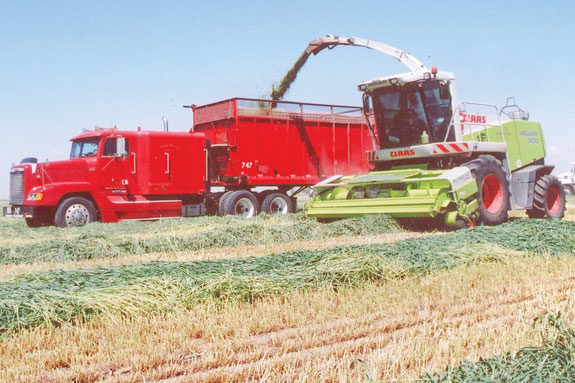Triticale, the wheat-rye hybrid, was made fertile by scientists during the 1930s, and is now considered a separate species. The varieties in use today in the U.S. mostly came from the breeding program of Dr. B. Charles Jenkins, a native of Canada who moved to California, and released the first commercial variety in 1968.
At first, all the varieties were dual-purpose, and the emphasis was on developing the food market. It soon became apparent that changing our food culture would be a long and expensive proposition. However, triticale as a forage crop started to make its mark, and the breeders began to select lines that were superior for their quantity and quality of forage.
While slow progress is still being made in food triticale, the great percentage of triticale varieties being grown now were bred to be a forage crop. Most of these are plant variety protected lines.
The triticale acres in the southern Great Plains have now outgrown the capacity of local growers to harvest all their acres. This opens up an opportunity for custom silage harvesters to expand their business beyond corn and alfalfa. Before, wheat was a crop of opportunity to cut, due to price and disasters, but now triticale makes the spring silage business more stable and predictable. I asked some custom cutters what that means to them economically.
John Jimenez of Clovis and Portales, New Mexico, not only has a silage-cutting business, but also farms and dairies. His corn harvesters will go as far south as San Angelo, Texas, but he cuts wheat and triticale mostly in his home counties. He says that triticale is not as profitable to cut as corn, but is better than wheat because it makes more tons per acre.
Triticale is harder on his equipment than corn because of the rocks and dirt that are picked up in the swath. Knives must be sharpened twice as often, as sharp knives are critical in getting a good pack. Many dairies in his area use plastic silage bags and prefer a 1.5-inch cut, but if triticale is to go in a pit, it needs a 0.75-inch cut (17 millimeters) to be properly packed. Triticale takes more packing than corn, but because you can’t run as many tons per hour through a chopper as with corn, the tractors at the pit can keep up.
John charges an extra dollar per ton to chop triticale compared to corn, and since trit must be swathed that adds another dollar per ton to the cost of harvest.
Phillip Zeller and sons of Herrington, Kansas, use four choppers in their custom operation. He is glad to add triticale to his route, and is looking for more acres to cut because it spreads the cost of equipment out over more acres, and aids his cash flow. He sometimes travels south as far as Throckmorton, Texas, and goes up to the Nebraska line.
He noted the same maintenance problems as the other cutters, but said he expects triticale acres to continue to expand due to the lower water requirements of trit compared to corn, especially on farms over the Ogallala aquifer.
Leroy Schulte, Nazareth, Texas, chops mostly within 50 miles of home, and has noticed that his customers are happy with the crop. He is not happy with the extra time spent sharpening knives, but admits it is more profitable than chopping wheat. It also helps his cash flow, and keeps his core labor force intact for the corn season.
Bruce Hines of Coolidge, Kansas, says that triticale yields from 2 to 5 tons more per acre than wheat. He wishes he could always cut in a circle in center pivot fields, and that the grower would let him leave a few inches on either side of the irrigation track to cut down on wear-and-tear on his equipment. Swathing sometimes causes timing problems, especially when the weather does not cooperate.
Dan Appelhans of Friona, Texas, stays fairly close to home with his chopping business, and tries to only cut trit fields that will yield more than 14 tons per acre. Scott Johnson of Farwell says he would rather cut corn, but cuts trit to keep his customer base. Because of the varying time that trit must be in the swath due to crop maturity and weather, it can be frustrating to match the swather to the chopper.
Lloyd Schneider of Logan, Kansas, noticed that, too. It is critical that trit be put up between 65 percent and 68 percent moisture, and this adds time constraints to the operation.
Darren and Galen Wentz, Norcatur, Kansas, have a route that takes them from Louisiana to Nebraska. They do not take a swather on the road, but rely on local cutters. Most of the triticale they cut is in Kansas. Like others, they noted the extra knife sharpening and maintenance problems. They also noted that for quality, too many growers seem to wait too long to swath to obtain optimum results. Triticale protein drops about one-fourth of a point of protein per day from the flag leaf stage until soft dough. The best compromise seems to be to cut at the boot stage.
In general, all the custom choppers agreed that trit is not as profitable to cut as corn, but it is better than wheat. Most of them expect the acreage of triticale to continue to grow. FG
PHOTO: Due to price and disasters, wheat was a crop of opportunity to cut, but now triticale can make the spring silage business more stable and predictable. Photo courtesy of Andy Watley.











